Lemon Pavlova for dessert? Yes, please.
Make this amazing, melt in your mouth, Lemon Pavlova for family, friends or a special get-together. This easy and delicious recipe is for all skill levels.
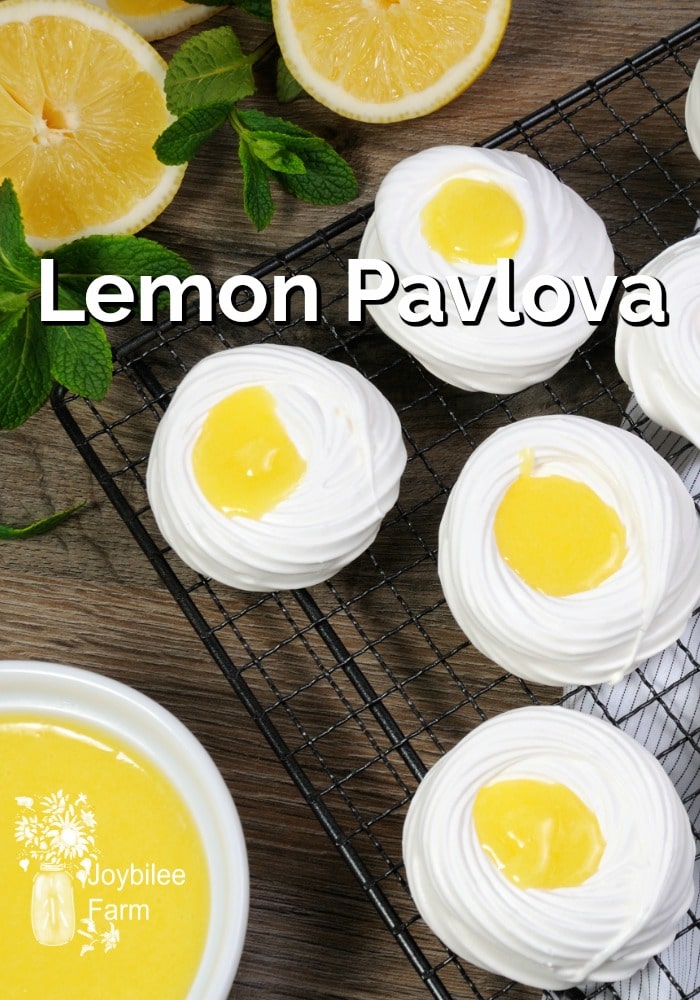
Spring and eggs go together. Are you getting an overabundance yet? I found a great way to use up some extra eggs and you get dessert, too. Grab that maple macchiato for 2 and this amazing, melt in your mouth, Lemon Pavlova, and you are ready for a date night at home. The only thing missing is dark chocolate and flowers.
And while your meringues are cooling in the oven, you’ll want to have a look at this inspiring book by Missionary Mom Stasia Nielson. This is a combination of missionary memoirs and cookbook — and Stasia is well qualified to write a cookbook in her capacity as a hostess at an international mission centre.
Book review: “Tiastasia’s food Memoirs from around the world” — 4 stars
I downloaded a free review copy of “Tiastasia’s Food Memoirs from around the world” by Stasia Nielsen because it sounded like my favourite kind of cookbook. I love a cookbook with both recipes and stories. Make it an international cookbook with dishes from many cuisines and you’ve hooked me. This one is especially poignant because it promised to be stories of a missionary family – stories of faith.
The cookbook-memoir is a generous 145 pages, filled with great recipes. While some of them use convenience food that I don’t have in my house, like onion soup mix, and evaporated milk, it’s easy enough for an experienced cook to find scratch substitutes – caramelized onions, and whole milk, for instance. The majority of the recipes are from scratch. Some of them use ingredients that you might have to hunt for at an ethnic market such as kaffir lime leaves. I’ve never heard of them. It would have helped if these more exotic ingredients were listed in a glossary so that the reader would know what they are or where to find them.
The day I read the book I was preparing a dessert for a luncheon the following day. So I scanned the recipes looking for something that I already had all the ingredients for. I settled on Pavlova on page 30, knowing I’d need to make some substitutions. I was sadly lacking in fresh Kiwis and fresh strawberries since it’s actually February here in the North. Eggs, however, I have in abundance, as well as lemons. Since I also had 2 cups of heavy cream for whipped cream, I thought it would be a perfect dessert.
I made the Lemon curd recipe on p. 37 with a few minor changes, substituting 12 egg yolks for the 6 whole eggs in the recipe, which would give me 12 egg whites to use in the Pavlova. Since the Pavlova recipe serves 15, it didn’t hurt to cut the Pavlova recipe down by 1/3rd and make it with just 12 egg whites.
Here’s my dessert recipe, inspired by Tiastasia’s Food Memoirs
Lemon Pavlova Recipe
Inspired Lemon Curd (p. 37)
(Makes 3 pints)
12 egg yolks
Zest from 6 lemons
Juice from 6 lemons
¾ cup of butter
3 cups of organic sugar (if you prefer the lemon curd less sweet you can cut back the sugar to 2 1/2 cups.)
Mix all ingredients together. Put in a heavy bottom saucepan and stir over low heat until the mixture bubbles and thickens. Spoon into hot, sterilized jars. Complete 2 part lids. Cool at room temperature and then refrigerate. Makes 3 pints. (You’ll use 3 cups for this dessert and have 3 cups for spreading on toast or filling tart shells.)
Stasia’s recipe calls for cooking in a double boiler, which I lack. So I cooked it on top of my wood cookstove on medium heat, stirring as necessary but not constantly. While the lemon curd came up to temperature on the woodstove, I made the meringue shells for the Pavlova.
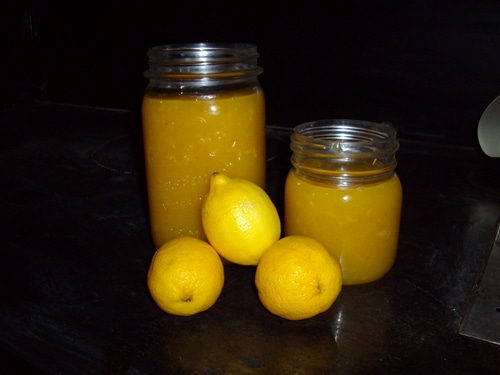
Inspired Pavlova Meringue shells (p. 30)
(Makes 6 – 7 inch meringue shells)
Whites from 12 eggs, at room temperature
1 tsp. cream of tartar
4 tsp. vanilla extract
1 1/2 cups of organic sugar
Beat egg whites for 1 minute on medium speed with your electric mixer, or hand beater. Add 1 tsp. cream of tartar and beat for another minute. Add 4 tsp. vanilla extract and beat for another minute. The mixture will foam and begin to form peaks. Add sugar ¼ cup at a time while continuing to beat at medium speed. Allow the sugar to dissolve completely after each addition until 1 1/2 cups of sugar have been added.
Continue beating until stiff peaks form and the meringue is glossy.
Meanwhile, preheat the oven to 325F. Cover 3 baking sheets with baking paper. Draw two 7 inch circles on each baking sheet/paper. Spoon 1/6th of the mixture, about 2 cups, onto each circle, and spread evenly with a knife. Bake each baking sheet in the 325*F oven for 25 minutes. I was able to do two baking sheets at a time and the third baking sheet was held over in my wood oven on low. Once all three baking sheets have baked until they are golden brown. Turn off the oven; adjust the baking sheets so that all 3 can fit in the oven at once. Allow them to cool in the oven naturally. I left it overnight and they came out the perfect texture – crisp and dry on the outside and chewy, soft on the inside.
The meringues will rise and expand as they bake but then shrink as they cool.
Once they are cool, remove them from the baking sheet and gently peel the baking paper from the underside of the meringue, being careful not to break the meringue shell. If it does break, don’t worry, just piece it back together, on a plate. It will be covered with whip cream and lemon curd so it won’t look bad. And it will taste amazing. The Pavlova uses 4 meringues and you’ll have two left for another dessert.
Whipped Cream Topping
2 cups of heavy cream
2 tbsp. organic sugar
1 tsp. vanilla
Beat cream, sugar and vanilla together until thick and stiff peaks are formed.
Assemble the Lemon-Pavlova
You’ll need:
4 Meringue shells
3 cups of lemon curd
4 cups of heavy whipped cream
You’ll want to assemble the Pavlova just before serving so that the crispness of the meringue is not compromised. I took the meringues on a plate, the lemon curd in a jar, and the whipped cream in a covered bowl to the event that we were attending, and assembled the Pavlova just before dinner.
Place the first meringue on a cake plate. Put a 1/3 cup of whipped cream on top of the meringue, and spread evenly with a knife. Put another meringue on top of that and spread 1/3rd cup of whip cream over the top. Place the third meringue over this and put 1 cup of lemon curd on this one and spread it evenly. Spoon 2 cups lemon curd on top of the topmost meringue and top with whipped cream. Serves 8 to 10.
It was a sensational dessert and well-liked by everyone that tried it. I’m definitely going to add it to my repertoire with one caveat. I found Stasia’s recipe too sweet and my version here has about 25% less sugar than the recipe on page 30 in the book.
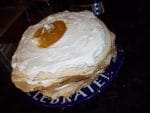
Lemon Pavlova
- Prep Time: 1 hour
- Cook Time: 25 minutes
- Total Time: 2 hours
- Yield: 8-10 servings 1x
- Category: Dessert
- Method: n/a
- Cuisine: Russian
Description
A light and tasty dessert, perfect for any gathering.
Ingredients
Lemon Curd (filling):
- 12 egg yolks
- Zest from 6 lemons
- Juice from 6 lemons
- ¾ cup of butter
- 3 cups of organic sugar (if you prefer the lemon curd less sweet you can cut back the sugar to 2 1/2 cups.)
Meringue:
- Whites from 12 eggs, at room temperature
- 1 tsp. cream of tartar
- 4 tsp. vanilla extract
- 1 1/2 cups of organic sugar
Whipping Cream (topping):
- 2 cups of heavy cream
- 2 tbsp. organic sugar
- 1 tsp. vanilla
Instructions
Lemon Curd:
- Mix all ingredients together.
- Put in a heavy bottom sauce pan and stir (or whisk) over low heat until the mixture bubbles and thickens.
- Lemon curd should coat the spoon when it is thick enough.
- Spoon into hot, sterilized jars. Complete 2 part lids.
- Cool at room temperature and then refrigerate.
- Makes 3 pints. (You’ll use 3 cups for this dessert and have 3 cups for spreading on toast or filling tart shells.)
Meringue Base:
- Beat egg whites for 1 minute on medium speed with your electric mixer, or hand beater.
- Add 1 tsp. cream of tartar and beat for another minute.
- Add 4 tsp. vanilla extract and beat for another minute.
- Mixture will foam and begin to form peaks.
- Add sugar ¼ cup at a time while continuing to beat on medium speed.
- Allow the sugar to dissolve completely after each addition until 1 1/2 cups of sugar have been added.
- Continue beating until stiff peaks form and the meringue is glossy.
- Meanwhile, preheat oven to 325F. Cover 3 baking sheets with baking paper. Draw two 7 inch circles on each baking sheet/paper. Spoon 1/6th of the mixture, about 2 cups, onto each circle, and spread evenly with a knife. Bake each baking sheet in the 325*F oven for 25 minutes.
- Once all three baking sheets have baked until they are golden brown. Turn off the oven; adjust the baking sheets so that all 3 can fit in the oven at once.
- Allow to cool in the oven naturally.
- The meringues will rise and expand as they bake but then shrink as they cool.
- Once they are cool, remove from the baking sheet and gently peel the baking paper from the underside of the meringue, being careful not to break the meringue shell.
- If it does break, don’t worry, just piece it back together, on a plate. It will be covered with whip cream and lemon curd so it won’t look badly.
- The Pavlova uses 4 meringues and you’ll have two left for another dessert.
Whipping Cream:
- Beat cream, sugar and vanilla together until thick and stiff peaks are form.
Assembling the Pavlova:
- You’ll want to assemble the Pavlova just before serving, so that the crispness of the meringue is not compromised.
- Place the first meringue on a cake plate.
- Put a 1/3 cup of whipped cream on top of the meringue, and spread evenly with a knife.
- Put another meringue on top of that and spread 1/3rd cup of whip cream over the top.
- Place a third meringue over this and put 1 cup of lemon curd on this one and spread it evenly.
- Spoon 2 cups lemon curd on top of the topmost meringue and top with whipped cream.
Let me tell you about the book:
I enjoyed the book. It made me cry, not from cutting onions but from the heartwarming stories of Stasia’s missionary adventures. The stories span 30 years of ministry and recount memories that changed her – encounters with the poor and the isolated, encounters with strange food like chicken beaks and feet, and encounters with Jehovah Jirah and how God provides when you live by faith. These stories made me grateful that God didn’t call ME to the foreign mission field. I’m sure I wouldn’t have shone as brightly as Stasia, after such encounters.
Stasia doesn’t mention her family much except to tell that she was pregnant or what ages her children were, as she recounts certain adventures. Perhaps she was protecting their privacy, but I found myself wanting to know, how Stasia’s children accepted the spicy cuisine of Mexico or Thailand and how they coped with so many different foods. The stories weren’t about food so much, as about Stasia’s missionary lifestyle and some of the challenges that she faced. I would have liked to hear more food stories – stories around some of the actual recipes that she shared. There is a disconnect between the recipes and the memoirs – like they could easily be two different books.
I gave the book 4 stars. I wanted to give this book 5 stars. I loved the stories. There were funny stories, amazing stories of courage and fortitude, stories of faith, and stories of love. Some made me cry with laughter, and some made me cry for the sheer miracle of it all. The recipes drew from several cuisines and were well written and easy to follow. I loved the variety of recipes, too. There were many recipes for each category: baking, desserts, breakfasts, vegetables and sides, meat and main dishes, appetizers, soups and salads, and beverages.
But I could only give it 4 stars because the book lacked a linked table of contents and index. Once I’d read through the 145 pages and wanted to go back to try a recipe, I had to scroll through the whole book to find the chapter I wanted – none of the chapters are linked – at least they weren’t in the review copy that I had. Then I had to scroll through the chapters to locate the specific recipe I wanted to try. That makes it a bit more effort to actually use the cookbook as a cookbook. If the book had a linked Table of Contents it would be an easy 5 stars.
The other drawback was the use of packaged foods – like evaporated milk, self-rising flour, honey-mustard dressing, and frozen dairy topping — why not milk, flour and baking powder, a recipe for the dressing, and whipped cream? While most recipes were from scratch, the occasional use of convenience foods seemed out of place. A glossary would have been helpful to tell me where to purchase exotic foods that aren’t necessarily available in my local grocer or even offer a suggestion for a substitute.
I would have enjoyed more stories that were actually connected to the recipes rather than the disconnect between the stories and the recipes, like tell me not just how to make gnocchi but describe an experience you had with your family while you made them together. Entering the lives of others through true stories is what enriches us and gives us hope. But perhaps that would have made this book too huge.
This book would be ideal for you if you love international cooking, and enjoy real-life stories of God-encounters. Many of the recipes are the kinds of dishes you’d take to a church potluck or family gathering, so I could see this book getting a lot of use.



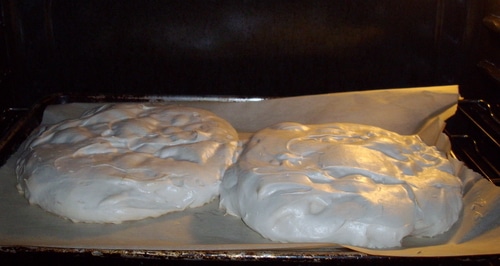
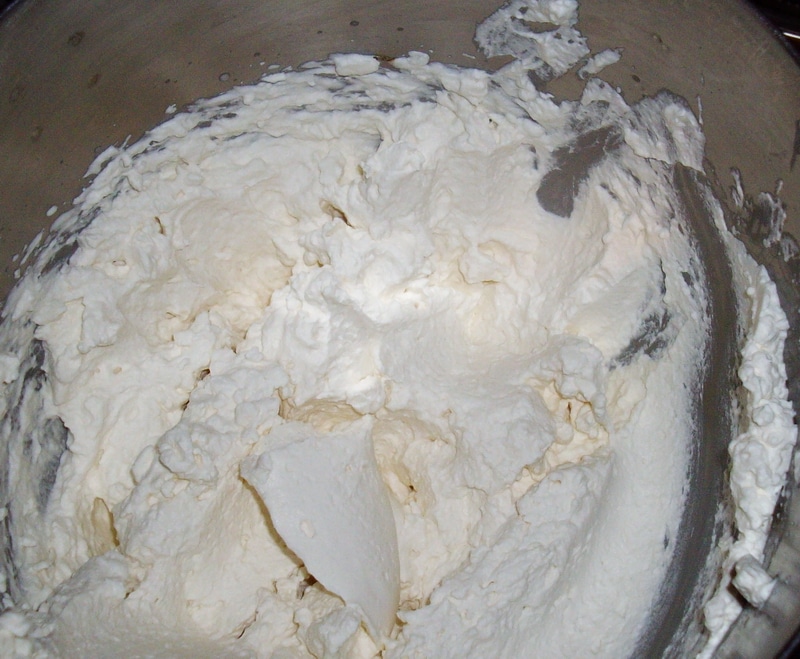
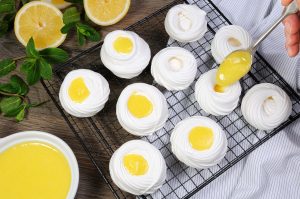

Leave a Reply